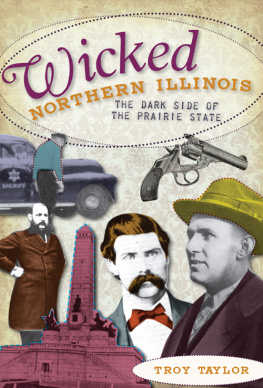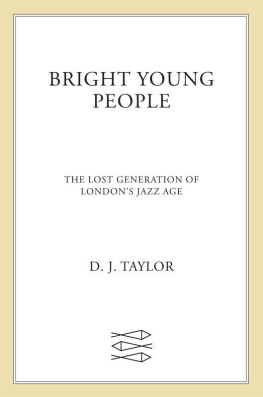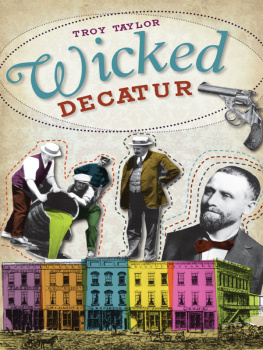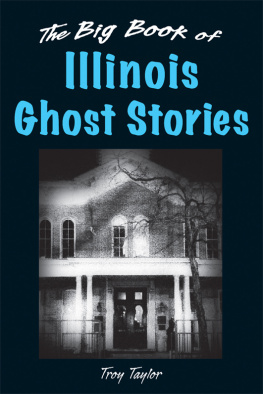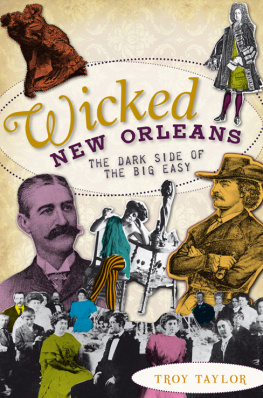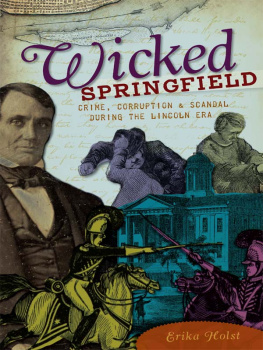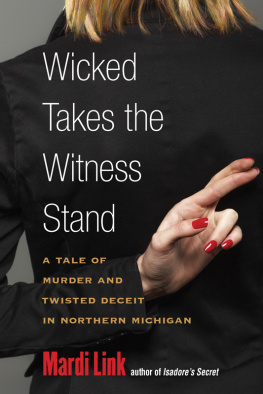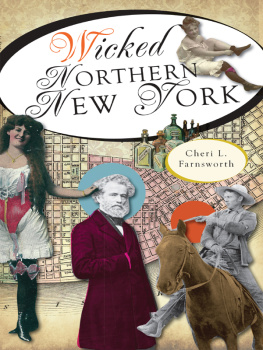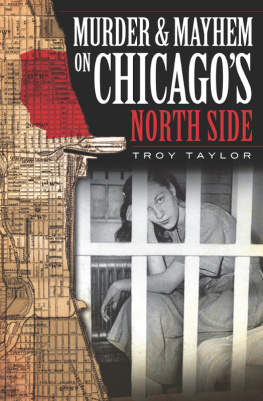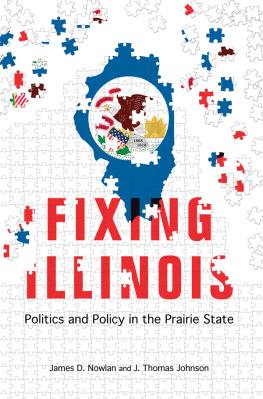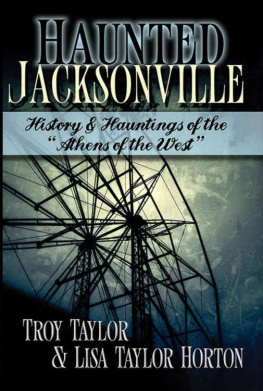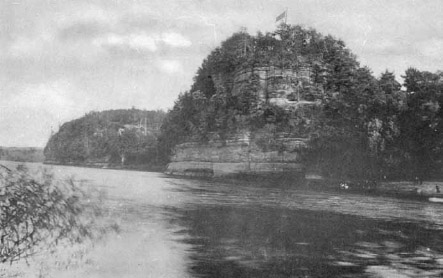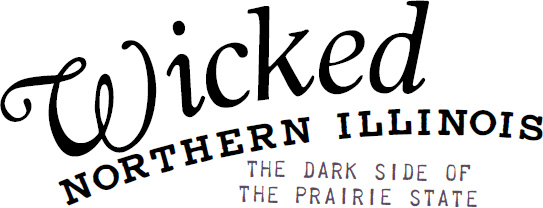A photograph of Starved Rock, taken in the early 1900s, showing its location on the Illinois River. The site was the scene of legendary bloodshed during the 1700s and went on to become a place of horror after a triple murder galvanized Northern Illinois in 1960.
Taylor, Troy.
Wicked northern Illinois : the dark side of the Prairie State / Troy Taylor.
p. cm.
Includes bibliographical references.
print edition ISBN 978-1-59629-278-9 1. Violent crimes--Illinois--History--Anecdotes. 2. Murder--Illinois--History--Anecdotes.
3. Crime--Illinois--History--Anecdotes. 4. Criminals--Illinois--Biography--Anecdotes. 5. Victims of crimes--Illinois--Biography--Anecdotes. 6. Illinois--History--Anecdotes. 7.
Illinois--Biography--Anecdotes. 8. Illinois--Social conditions--Anecdotes. I. Title.
HV6793.I3T395 2010
364.1097732--dc22
2010031975
All rights reserved. No part of this book may be reproduced or transmitted in any form whatsoever without prior written permission from the publisher except in the case of brief quotations embodied in critical articles and reviews.
Acknowledgements
I would like to thank the many other writers and chroniclers of Illinois history and crime who came before me, especially Herbert Asbury, Jay Robert Nash, Paul Angle, Randall Parrish, Milo Quaife and Stu Fliege. Id also like to thank my friend John Winterbauer for his continued assistance with all things dark and my editor at The History Press, Ben Gibson, who put up with my many quirks and oddities. And finally, thanks to my wife, Haven, for her continued patience and love and for really getting me into this mess when she suggested that I write about something other than ghosts. She said to me, You love crime history, too. Why dont you write about that? Thus, my other writing began.
INTRODUCTION
A Bloody History of Early Illinois Crime
Illinois was, in many ways, born in blood. From the Indian massacres of the War of 1812 to the feuds and vendettas in the late 1800s, there is a long history of violence and death written in blood during the early days of the state. But almost every part of the country in its early days of scant population was the scene of open crime. Outlaws, fleeing in desperation from the restraints of civilization, where the law was strictly enforced, found the wilderness a region where they could carry on their lawless ways. The settlements in those days were small and widely scattered, with broad spaces of unknown forest and prairie lying in between. The beleaguered upholders of the law, if any such men were even on duty, were unable to be everywhere at once. It was easy in those days to operate in secrecy, and the very life of the frontier bred a class of rough and desperate men, capable of committing almost any crime.
There is likely no part of Illinois that does not have its local traditions of outlawry during its period of early settlement, including the northern reaches of the state. There, tales that were often weird and gruesome were told for years until a time came when popular sentiment became too strong to harbor criminals. Even today, there are locations that are pointed out as murder sites and places where gangs of outlaws once hid. Often, these tales are so filled with lore that it is hard to tell where truth ends and fiction begins. Regardless, they paint a vivid portrait of how Illinois came to be and why it gained such a reputation as a lawless place.
I NDIAN M ASSACRES
The first French explorers came to Illinois in 1763, when an expedition led by Louis Jolliet and Father Jacques Marquette journeyed down the Mississippi River. Jolliet was an explorer and mapmaker, while Marquette was a Jesuit priest who longed to bring his religion to the native people of the wilderness. These two, along with several Indians and nineteen other white men, undertook a treacherous journey that brought them all the way to the mouth of the river. They crossed land on their return journey, paddling northward on the Illinois and Des Plaines Rivers to Lake Michigan, and opened the wilderness of Illinois for the French settlers and adventurers who followed.
Men like LaSalle conquered the region, and from 1698 to 1722, the French expanded throughout the Lower Mississippi Valley. Settlements began to appear at Kaskaskia, Cahokia, St. Genevieve and Fort de Chartres. In 1763, the city of St. Louis was founded, and not long after, settlers, explorers and fur traders flocked to the Illinois country. The region remained under French control for years, until it was given to Spain, returned to France in 1800 and then sold to the United States in 1803.
The years that followed were a period of lawlessness and lack of order for Illinois. The region was initially a part of the state of Virginia and then became the Illinois Territory in 1809. By this time, settlers from the East had started to arrive in the area, and with them came myriad problems and a great threat to the Indian populace. The threat of encroachment, combined with another war with England, led to the first blood being spilled in Illinois.
When the War of 1812 began, the Illinois Territory became an integral part of the fighting. Along the East Coast and the Canadian border, the American forces fought against British invasion. Illinoisat the time, the far western frontierwas left out of this part of the war, but the state was torn apart by terrible massacres and battles with Indian allies of the British, who created more havoc and committed more horrific murders than the British could ever dream of. Shortly after the outbreak of the war, the infamous Fort Dearborn Massacre took place at the site of present-day Chicago.
The site of Fort Dearborn was staked out by Captain John Whistler in April 1803. His orders had been to take six soldiers from the First U.S. Infantry, survey a road from Detroit to the mouth of the river and draw up plans for a fort at this location.
There were sixty-nine officers and men in the contingent that had the task of building Fort Dearborn, named in honor of Secretary of War Henry Dearborn, a man who would go on to be considered one of the most inept leaders in American history. The hill on which Fort Dearborn was built was eight feet above the Chicago River. The water curved around it and, stopped from flowing into a lake by a sandbar, ran south until it found an outlet. To this spot, the soldiers hauled the wood that had been cut along the north bank. The fort was a simple stockade built of logs, which were placed in the ground and then sharpened along the upper end to discourage attackers. The outer stockade was a solid wall with an entrance in the southern section blocked with heavy gates. An underground exit was located on the north side. As time went on, the soldiers built barracks, officers quarters, a guardhouse and a small powder magazine made from brick. West of the fort, they constructed a two-story log building with split-oak siding to serve as an Indian agency, and between this structure and the fort they placed root cellars. South of the fort, the land was enclosed for a garden. Blockhouses were added at two corners of the fort, and three pieces of light artillery were mounted at the walls. The fort offered substantial protection for the soldiers garrisoned there, but they would later learn that it was not enough.

